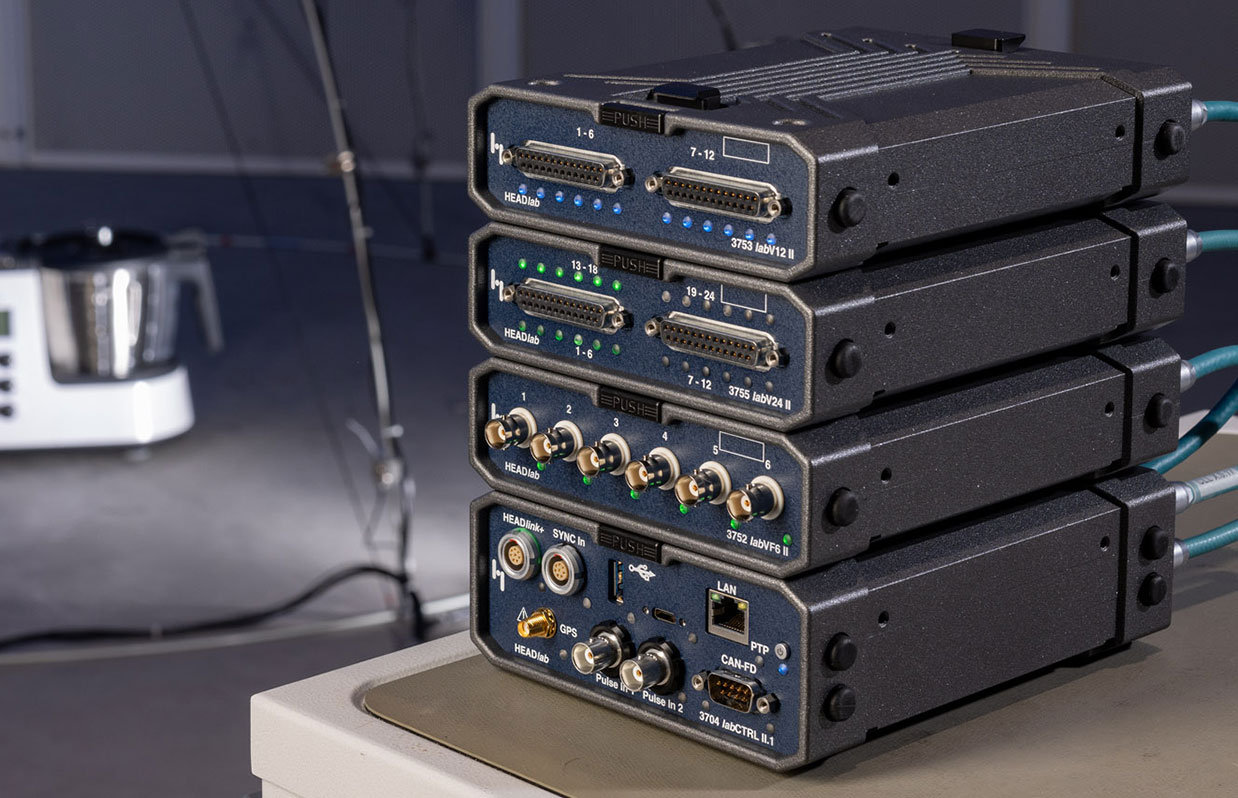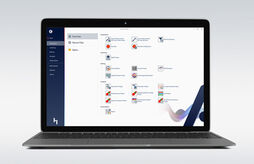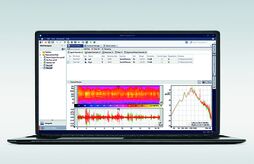HEADlab II – Next generation modular multi-channel data acquisition system for sound and vibration measurement
The new generation of the modular HEADlab data acquisition system is even more suitable...
The new generation of the modular HEADlab data acquisition system is even more suitable for challenging mobile applications than its predecessor. The new models with their clear and rugged design for multi-channel sound and vibration measurement provide high data rates, CAN-FD support and synchronization capabilities via GPS and LAN (PTP).
HEADlab II systems consist of one or several controllers with various input, playback and power supply modules. They are easy to configure: Users choose which modules to combine with a controller. The modules used for diverse sensor types depending on the individual application are robust, flexible to combine as well as fan- and noise-free. An integrated locking mechanism allows the modules to form robust units and to be easily disconnected again.
The heart of the HEADlab II system is the powerful controller labCTRL II.1 with its new interface protocol HEADlink 2.0, allowing sample rates from 8 to 204.8 kHz per channel. labCTRL II.1 concentrates and synchronizes data, supplies power to connected modules and establishes the connection to the PC. The connection of multiple controllers allows the expansion of systems up to several hundred channels. Further accessories (e.g. Isofix mount for crash-proof installation in the vehicle) allow HEADlab II systems to be transported conveniently and securely and to be mounted almost anywhere.
All HEADlab modules of HEADlab generation I and II are fully compatible with each other. HEADlab modules of generation I can be combined with a controller of generation II. Likewise, the new input modules can be combined with a Generation I controller using the HEADlink 1.0 protocol (data rate as for HEADlab Generation I modules). Mixed operation is also possible, whereby it is negotiated per HEADlink connection which protocol can be used. Full flexibility is therefore guaranteed.
The new generation of the modular HEADlab data acquisition system is even more suitable for challenging mobile applications than its predecessor. The new models with their clear and rugged design for multi-channel sound and vibration measurement provide high data rates, CAN-FD support...
The new generation of the modular HEADlab data acquisition system is even more suitable for challenging mobile applications than its predecessor. The new models with their clear and rugged design for multi-channel sound and vibration measurement provide high data rates, CAN-FD support and synchronization capabilities via GPS and LAN (PTP).
HEADlab II systems consist of one or several controllers with various input, playback and power supply modules. They are easy to configure: Users choose which modules to combine with a controller. The modules used for diverse sensor types depending on the individual application are robust, flexible to combine as well as fan- and noise-free. An integrated locking mechanism allows the modules to form robust units and to be easily disconnected again.
The heart of the HEADlab II system is the powerful controller labCTRL II.1 with its new interface protocol HEADlink 2.0, allowing sample rates from 8 to 204.8 kHz per channel. labCTRL II.1 concentrates and synchronizes data, supplies power to connected modules and establishes the connection to the PC. The connection of multiple controllers allows the expansion of systems up to several hundred channels. Further accessories (e.g. Isofix mount for crash-proof installation in the vehicle) allow HEADlab II systems to be transported conveniently and securely and to be mounted almost anywhere.
All HEADlab modules of HEADlab generation I and II are fully compatible with each other. HEADlab modules of generation I can be combined with a controller of generation II. Likewise, the new input modules can be combined with a Generation I controller using the HEADlink 1.0 protocol (data rate as for HEADlab Generation I modules). Mixed operation is also possible, whereby it is negotiated per HEADlink connection which protocol can be used. Full flexibility is therefore guaranteed.
Highlights
- Better performance with new HEADlink 2.0 protocol: higher sample rates, more channels ...
- Better performance with new HEADlink 2.0 protocol: higher sample rates, more channels
- New 24-channel input module
- Synchronization of independent measuring systems via GPS or PTP
- Native CAN FD support
- Stand-alone recording
- Fresh, powerful design
- Mobile: The integrated battery allows for recordings at measurement locations without a direct power supply.
- Flexible: The multi-channel system, comprising the controller and input and power supply modules, can be individually assembled.
- Silent: HEADlab operates without fans, minimizing background noise.
- Modular: One controller supplies up to 10 modules. Several such HEADlab systems can be connected to form larger, synchronized systems with several hundred channels.
- Versatile: Different input modules with connection options for binaural sensors, microphones (ICP®/condenser microphones), speed, pressure, temperature, charge sensors, measuring bridges (strain gages), CAN FD/CAN, OBD‑II and FlexRay sources, GPS receivers and highly resistive voltage sources
- Individual modules can be replaced in a very simple procedure.
- Power-saving operation of control and input modules.
- Systems are light yet robust.
- Modules, PC and power supply are electrically isolated.
- Better performance with new HEADlink 2.0 protocol: higher sample rates, more channels
- New 24-channel input module
- Synchronization of independent measuring systems via GPS or PTP
- Native CAN FD support
- Stand-alone recording
- Fresh, powerful design
- Mobile: The integrated battery...
- Better performance with new HEADlink 2.0 protocol: higher sample rates, more channels
- New 24-channel input module
- Synchronization of independent measuring systems via GPS or PTP
- Native CAN FD support
- Stand-alone recording
- Fresh, powerful design
- Mobile: The integrated battery allows for recordings at measurement locations without a direct power supply.
- Flexible: The multi-channel system, comprising the controller and input and power supply modules, can be individually assembled.
- Silent: HEADlab operates without fans, minimizing background noise.
- Modular: One controller supplies up to 10 modules. Several such HEADlab systems can be connected to form larger, synchronized systems with several hundred channels.
- Versatile: Different input modules with connection options for binaural sensors, microphones (ICP®/condenser microphones), speed, pressure, temperature, charge sensors, measuring bridges (strain gages), CAN FD/CAN, OBD‑II and FlexRay sources, GPS receivers and highly resistive voltage sources
- Individual modules can be replaced in a very simple procedure.
- Power-saving operation of control and input modules.
- Systems are light yet robust.
- Modules, PC and power supply are electrically isolated.
Features
- The controller synchronizes the channels in a HEADlab system accurate to sample.
- Depending on the HEADlink protocol, the input modules feature high phase accuracy of the 24-bit or 32-bit data and an outstanding signal-to-noise ratio.
- Controller and input modules are available with different sensor types for a wide range of applications. Sensors to be connected directly or using adapters:
- Digital artificial heads of the HMS series
- Binaural HEAD acoustics sensors, e.g. BHS II or BHM III
- ICP® sensors (TEDS)
- Condenser microphones, including low-noise microphones (TEDS)
- Pressure, temperature sensors (DC) etc.
- Strain gages
- Charge sensors
- Speed sensors
- CAN FD, CAN, OBD-II (including WWH-OBD), FlexRay
- Highly resistive voltage sources
- GPS/PTP receivers
- Audio, ADAT and AES devices, sinus generators, oscilloscopes, headset amplifiers, etc.

HEADlab Modules
A variety of HEADlab modules is available ensuring the system can be tailored according to all needs.










